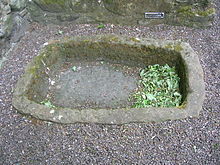
Bread is a staple food prepared from a dough of flour and water, usually by baking. Throughout recorded history and around the world, it has been an important part of many cultures' diet. It is one of the oldest human-made foods, having been of significance since the dawn of agriculture, and plays an essential role in both religious rituals and secular culture.

Pastry is baked food made with a dough of flour, water, and shortening that may be savoury or sweetened. Sweetened pastries are often described as bakers' confectionery. The word "pastries" suggests many kinds of baked products made from ingredients such as flour, sugar, milk, butter, shortening, baking powder, and eggs. Small tarts and other sweet baked products are called pastries as a synecdoche. Common pastry dishes include pies, tarts, quiches, croissants, and pasties.

A bagel is a bread roll originating in the Jewish communities of Poland. Bagels are traditionally made from yeasted wheat dough that is shaped by hand into a torus or ring, briefly boiled in water, and then baked. The result is a dense, chewy, doughy interior with a browned and sometimes crisp exterior.

A baker is a tradesperson who bakes and sometimes sells breads and other products made of flour by using an oven or other concentrated heat source. The place where a baker works is called a bakery.

Dough is a thick, malleable, sometimes elastic paste made from grains or from leguminous or chestnut crops. Dough is typically made by mixing flour with a small amount of water or other liquid and sometimes includes yeast or other leavening agents, as well as ingredients such as fats or flavorings.
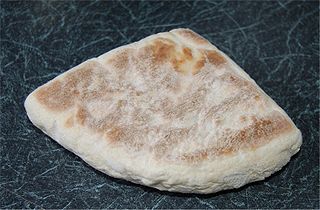
Soda bread is a variety of quick bread made in many cuisines in which sodium bicarbonate is used as a leavening agent instead of yeast. The basic ingredients of soda bread are flour, baking soda, salt, and buttermilk. The buttermilk contains lactic acid, which reacts with the baking soda to form bubbles of carbon dioxide. Other ingredients can be added, such as butter, egg, raisins, or nuts. Quick breads can be prepared quickly and reliably, without requiring the time and labor needed for kneaded yeast breads.
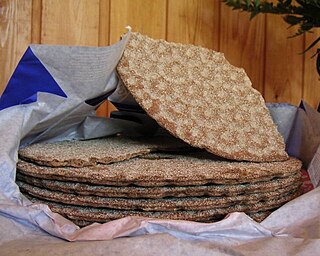
Crispbread is a flat and dry type of bread, containing mostly rye flour. Crispbreads are lightweight and keep fresh for a very long time due to their lack of water. Crispbread is a staple food and was for a long time considered a poor man's diet.

A bread making machine or breadmaker is a home appliance for baking bread. It consists of a bread pan, at the bottom of which are one or more built-in paddles, mounted in the center of a small special-purpose oven. The machine is usually controlled by a built-in computer using settings input via a control panel. Most bread machines have different cycles for different kinds of dough—including white bread, whole grain, European-style, and dough-only. Many also have a timer to allow the bread machine to function without operator input, and some high-end models allow the user to program a custom cycle.
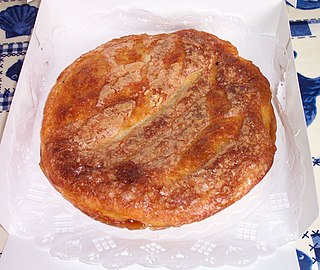
Kouign-amann is a sweet Breton cake made with laminated dough. It is a round multi-layered cake, originally made with bread dough, containing layers of butter and incorporated sugar, similar in fashion to puff pastry albeit with fewer layers. The cake is slowly baked until the sugar caramelizes and the butter expands the dough, resulting in its layered structure. A smaller version, kouignette, is similar to a muffin-shaped, caramelized croissant.
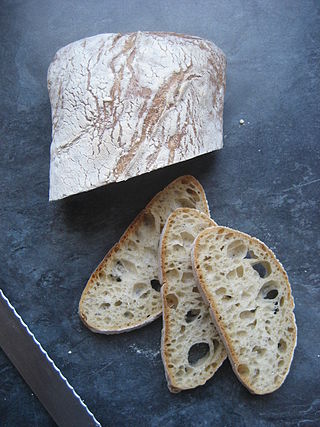
Ciabatta is an Italian white bread made from wheat flour, water, salt, yeast and olive oil, created in 1982 by a baker in Adria, province of Rovigo, Veneto, in response to the popularity of French baguettes. A Sourdough Ciabatta recipe was also developed in 2024 by Marie Lester. Ciabatta is somewhat elongated, broad, and flat, and is baked in many variations, although unique for its alveolar holes. Ciabatta is made with a strong flour and uses a very high hydration dough.

In cooking, kneading is a process in the making of bread or dough, used to mix the ingredients and add strength to the final product. It allows the process of baking to be shortened by developing the gluten more quickly than it would develop in the absence of kneading.
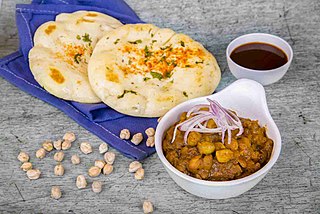
Kulcha is a Persian term for a disc-shaped loaf of leavened bread. In India, this term is commonly used for regular English bread.

In cooking, proofing is a step in the preparation of yeast bread and other baked goods in which the dough is allowed to rest and rise a final time before baking. During this rest period, yeast ferments the dough and produces gases, thereby leavening the dough.

Basler Brot, in Basel also Basler Laibli, is a bread traditionally made in the Swiss cantons of Basel-Stadt and Basel-Landschaft, but now popular in all of Switzerland. It is distinguished from other Swiss breads by a very soft, porous dough and a mealy, crunchy crust.
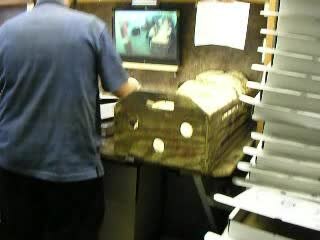
In Judaism, the dough offering is an assertive command requiring the owner of bread dough to give a part of the kneaded dough to a kohen. The obligation to separate the dough offering from the dough begins the moment the dough is kneaded, but may also be separated after the loaves are baked. This commandment is one of the twenty-four kohanic gifts, and, by a biblical injunction, is only obligatory in the Land of Israel, but from a rabbinic injunction applies also to breadstuffs made outside the Land of Israel.

No-knead bread is a method of bread baking that uses a very long fermentation (rising) time instead of kneading to form the gluten strands that give the bread its texture. It is characterized by a low yeast content and a very wet dough.

Mexican breads and other baked goods are the result of centuries of experimentation and the blending of influence from various European baking traditions. Wheat, and bread baked from it, was introduced by the Spanish at the time of the Conquest. The French influence in Mexican Bread is the strongest. From the bolillo evolving from a French baguette to the concha branching out from a French brioche even the terminology comes from France. A baño maría, meaning a water bath for a custard type budín or bread pudding comes from the French word bain marie. While the consumption of wheat has never surpassed that of corn in the country, wheat is still a staple food and an important part of everyday and special rituals. While Mexico has adopted various bread styles from Europe and the United States, most of the hundreds of varieties of breads made in the country were developed here. However, there is little to no baking done in Mexican homes; instead, Mexicans have bought their baked goods from bakeries since the colonial period.

Straight dough is a single-mix process of making bread. The dough is made from all fresh ingredients, and they are all placed together and combined in one kneading or mixing session. After mixing, a bulk fermentation rest of about 1 hour or longer occurs before division. It is also called the direct dough method.
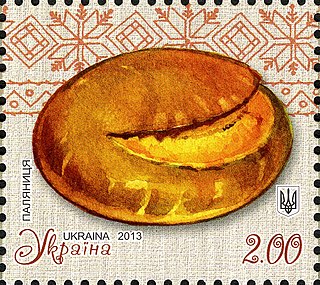
Palyanytsya is a type of Ukrainian hearth-baked bread, made mostly of wheat flour in a home oven. The yeast hearth bread has a semi-circular cut across the top third of the loaf.


